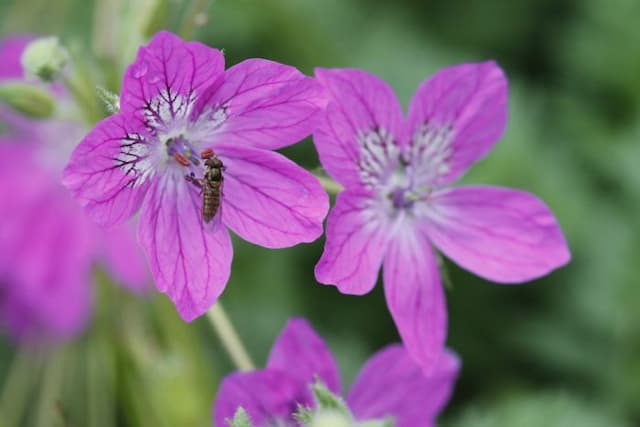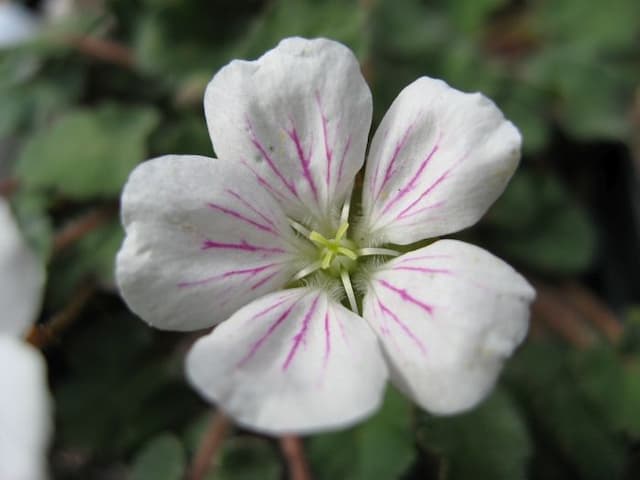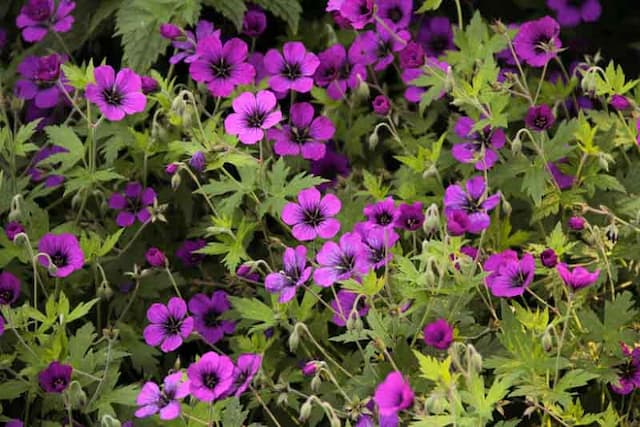Meadow Cranesbill Geranium pratense 'Plenum Violaceum' (d)

ABOUT
Often referred to as the meadow cranesbill, Geranium pratense 'Plenum Violaceum' is a perennial plant known for its highly decorative flowers and attractive foliage. The blossoms of this variety stand out with their rich violet-blue color and intricate, ruffled, and doubled petals, which create a dense, pompom-like appearance. The beauty of the flowers is enhanced by the prominent veining and the fine darker lines that converge to create a striking display. The leaves of the meadow cranesbill are deeply cut, lobed, and have a lacy appearance. They are usually bright green, creating a lush backdrop for the vibrant flowers. The plant has a bushy habit, with flowers blooming generously atop the foliage in a rounded cluster, presenting a stunning ornamental appeal throughout its blooming season.
About this plant
 Names
NamesFamily
Geraniaceae
Synonyms
Meadow Cranesbill, Rosy Geranium, Double-Flowered Meadow Cranesbill
Common names
Geranium pratense 'Plenum Caeruleum', Geranium pratense 'Flore Pleno'.
 Toxicity
ToxicityTo humans
Meadow Cranesbill is not known to be toxic to humans. Therefore, ingestion of this plant should not produce any symptoms of toxicity under normal circumstances.
To pets
Meadow Cranesbill is also considered non-toxic to pets. Consequently, it is not expected to cause symptoms of poisoning in animals if they ingest parts of the plant. However, ingestion of any plant material may cause mild gastrointestinal upset in some pets.
 Characteristics
CharacteristicsLife cycle
Perennials
Foliage type
Deciduous
Color of leaves
Green
Flower color
Violet
Height
2-3 feet (60-90 cm)
Spread
2-3 feet (60-90 cm)
Plant type
Herb
Hardiness zones
5
Native area
Europe
Benefits
 General Benefits
General Benefits- Aesthetic Appeal: Geranium pratense 'Plenum Violaceum', commonly known as Meadow Cranesbill, adds visual interest to gardens with its violet-blue, double-flowers and deeply lobed foliage.
- Pollinator Attraction: The plant attracts bees and butterflies, providing a food source for these beneficial insects and promoting pollination in the garden.
- Seasonal Interest: Meadow Cranesbill offers extended blooming from late spring to early fall, giving the garden a splash of color throughout the growing season.
- Drought Tolerance: Once established, it has good drought tolerance, making it a suitable choice for gardens in drier climates or for water conservation landscaping.
- Deer Resistance: It is generally resistant to deer, which can be particularly beneficial in areas where deer browse is a common problem.
- Low Maintenance: Requires minimal care beyond the initial planting and establishing period, making it a good option for gardeners seeking low-maintenance gardening solutions.
- Soil Adaptability: Meadow Cranesbill can adapt to a range of soil types, though it prefers well-draining soil, which makes it versatile for different garden settings.
- Cottage Garden Charm: The traditional look and naturalistic growth habit of the plant make it a perfect fit for cottage garden designs.
- Border and Ground Cover: The plant's mounding habit is ideal for garden borders, and when planted in groups, it can serve as an effective, attractive ground cover.
 Medical Properties
Medical Properties- Anti-inflammatory: The plant is sometimes used for its potential anti-inflammatory effects.
- Astringent: Traditionally, it has been utilized for its astringent properties to help with wound healing.
- Diuretic: It may act as a diuretic, promoting the excretion of urine.
- Mouthwash Ingredient: Due to its astringent quality, it's occasionally used in mouthwash formulations to soothe sore throats.
 Air-purifying Qualities
Air-purifying QualitiesThis plant is not specifically known for air purifying qualities.
 Other Uses
Other Uses- Natural dye: The deep violet flowers of the Meadow Cranesbill can be used to create natural dyes for fabrics or art projects.
- Garden design: With its striking color, the plant can serve as a focal point in garden beds or borders.
- Bee and butterfly attraction: It is effective in attracting pollinators like bees and butterflies to the garden, supporting biodiversity.
- Educational tool: Gardeners can utilize Meadow Cranesbill to teach about plant propagation as it can be easily divided.
- Companion planting: The plant can be used in companion planting schemes to enhance the growth of other plants and deter pests.
- Pressed flower art: The flowers of Meadow Cranesbill can be pressed and used in various arts and crafts for decoration.
- Photography subject: Garden photographers often use the intricate patterns and colors of the Meadow Cranesbill as the subject for their photos.
- Fairy gardens: Its delicate appearance makes it a popular choice for inclusion in whimsical fairy and miniature gardens.
- Wedding decor: Fresh or dried, the flowers can be used in creating natural and rustic wedding decorations.
- Potpourri: The petals can be dried and included in potpourri mixes for a subtle fragrance and splash of color.
Interesting Facts
 Feng Shui
Feng ShuiThe Meadow Cranesbill is not used in Feng Shui practice.
 Zodiac Sign Compitability
Zodiac Sign CompitabilityThe Meadow Cranesbill is not used in astrology practice.
 Plant Symbolism
Plant Symbolism- Unity and True Friendship - Geraniums, in general, are often associated with positive emotions and relationships, symbolizing a bond that is deeply rooted and sincere.
- Good Health - This plant is sometimes linked with wishes for good health, possibly because geraniums have historically been used for their medicinal properties.
- Unexpected Meeting - In the language of flowers, sometimes a geranium can indicate an unexpected encounter, which could be positive or challenging depending on the context.
- Stability and Balance - The sturdy nature of the geranium plant can be representative of stability in one's life, aiming for equilibrium in both personal and professional arenas.
- Fertility and Regeneration - With its ability to proliferate and produce abundant flowers, the geranium can symbolize new life and the continuous cycle of growth and rebirth.
 Water
WaterMeadow Cranesbill should be watered deeply but infrequently to encourage deep root growth, generally requiring about 1 inch of water per week either from rainfall or supplemental watering. During hot or dry periods, you may need to water twice a week, especially if the plant is in well-draining soil or a container. Check the soil moisture by feeling the top inch of soil before watering; if it's dry, it's time to water. It is better to water early in the morning to reduce evaporation and prevent fungal diseases. Be careful not to overwater, as Meadow Cranesbill does not like to sit in waterlogged soil.
 Light
LightMeadow Cranesbill thrives best in full sun to partial shade conditions. The ideal spot for this plant is one where it can receive at least 6 hours of sunlight daily, though it can tolerate some afternoon shade, especially in hotter climates. Avoid deep shade as it can lead to poor flowering and leggy growth.
 Temperature
TemperatureMeadow Cranesbill prefers temperate conditions and can generally withstand temperatures between 35°F and 75°F. They can survive brief periods of colder frosts and can handle temperatures down to around 20°F but may die back to the ground, returning in spring. The ideal temperature range for vigorous growth and flowering is between 60°F and 70°F.
 Pruning
PruningMeadow Cranesbill should be pruned to remove spent flowers and encourage a second bloom; deadhead regularly throughout the growing season. In early spring or after the first flush of blooms, cut back the plant by about half to rejuvenate foliage and improve its shape. Pruning can be done again in late fall or early winter to tidy up the plant after it dies back.
 Cleaning
CleaningAs needed
 Soil
SoilGeranium Plenum Violaceum, commonly known as Meadow Cranesbill, thrives best in moderately fertile, well-draining soil rich in organic matter with a pH of slightly acidic to neutral, ranging from 5.8 to 7.0. A good soil mix would be one part garden soil, one part peat moss or compost, and one part sharp sand or perlite to improve drainage.
 Repotting
RepottingMeadow Cranesbill does not typically require frequent repotting as it is usually grown as an outdoor perennial. However, if grown in containers, repot every 2-3 years or when the plant outgrows its pot, refreshing the soil mix to maintain nutrients.
 Humidity & Misting
Humidity & MistingMeadow Cranesbill prefers average ambient humidity and does not have specific high humidity requirements, making it well-suited to outdoor conditions in most temperate climates. Ensuring good air circulation will help maintain healthy humidity levels around the plants.
 Suitable locations
Suitable locationsIndoor
Place in bright, indirect light; ensure good airflow.
Outdoor
Plant in sun to part-shade, enrich soil, mulch, water well.
Hardiness zone
4-8 USDA.
 Life cycle
Life cycleGeranium pratense 'Plenum Violaceum', commonly known as Meadow Cranesbill, begins its life as a seed which, after a period of dormancy, germinates in the spring if the conditions are appropriate, requiring only a modest degree of light and moisture to sprout. The seedling develops a root system and foliage, gradually forming a compact, bushy perennial clump. Through spring and into summer, the plant will produce deeply lobed leaves and distinctive, dense clusters of violet-blue, ruffled double flowers, which are favored by pollinators such as bees and butterflies. After flowering, usually in late summer or early autumn, the plant sets seed in the form of a beaked capsule, earning it the name 'Cranesbill', as the capsules resemble the bill of a crane. Throughout the colder months, the foliage may die back, especially in colder climates, with the plant entering a period of dormancy. As temperatures rise with the return of spring, the plant will once again send up fresh growth, closing the cycle and beginning anew.
 Propogation
PropogationPropogation time
Early Spring
The most popular method for propagating Geranium pratense 'Plenum Violaceum', commonly known as Meadow Cranesbill, is via division. This is ideally done in the early spring or fall when the plant is not in active growth. To propagate by division, carefully dig up the plant, ensuring a generous root ball is kept intact, and use a sharp spade or knife to divide the clump into smaller sections, each with several shoots and a portion of the root system. Replant the divisions promptly, spacing them about 15-18 inches (approximately 38-46 centimeters) apart to allow for growth. Water the new divisions well to help establish them. Division helps to rejuvenate older plants while also providing new plants for the garden or to share with fellow gardeners.









![Cranesbill [Rothbury Gem]](/_next/image?url=https%3A%2F%2Fplants-admin.emdemapps.com%2Fimages%2Fplants%2F%2Fimages%2F604b6243984c2.png&w=640&q=75)